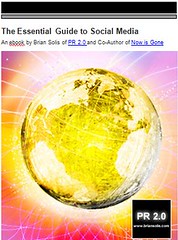Social Networks Now More Popular than Email; Facebook Surpasses MySpace

You heard that right...no matter how much time we sink into our inbox trying to keep up with all that barrage of never-ending mail, a new report sent over by Nielsen (thanks Sandra Parrelli) claims that Social networks and blogs are now the fourth most popular online activity today.

The report, "Global Faces and Networked Places," features data captured from December 2007 through December 2008 and reveals some very interesting statistics worth noting.
Here's are the highlights:
Two-thirds of the world’s Internet population visit social networking or blogging sites, accounting for almost 10% of all internet time
Time spent on social network sites is also expanding: Across the globe in 2008 activity in ‘Member Communities’ accounted for one in every 15 online minutes - now it accounts for one in every 11.
While social networks started out among the younger audience, they’ve become more mainstream with the passage of time.
This shift has primarily been driven by Facebook whose greatest growth has come from people aged 35-49 years of age (+24.1 million). From December 2007 through December 2008, Facebook added almost twice as many 50-64 year old visitors (+13.6 million) than it has added under 18 year old visitors (+7.3 million).
Facebook started out as a service for university students but now almost one third of
its global audience is aged 35-49 years of age and almost one quarter is over 50 years
old.

Time spent on social networks and blogs is growing at over 3x the rate of overall Internet growth.

The total amount spent online globally increased by 18% between December 2007 and December 2008. In the same period, however, the amount of time spent on ‘Member Community’ sites rose by 63% to 45 billion minutes; and 3.1 billion minutes to 20.5 billion. Facebook’s time is so high due to being the ninth most popular brand online and having the highest average time per person (three hours 10 minutes) amongst the 75 most popular brands online worldwide.
Social networks and blogs are eating into the share of time held by other sectors.
People under 18 years old are making up less of the social network and blogging audience, whereas the 50+ age group are accounting for more of the audience.

Facebook has replaced MySpace as the world's most popular social network.
Reasons contributing to Facebook's rapid growth:
- An organized and simple design
- Broad appeal
- Activity focus
- Architecture for applications, peer-to-peer activity influence, third-party developers have increased word-of-mouth and visitor engagement
- Privacy
- Media coverage

Related Posts on PR 2.0:
- I Like You: The Emerging Culture of Micro Acts of Appreciation
- BackType Connects the Conversation Graph
- Tracking Brands on Twitter to Improve How You Listen and Engage
- Facebook Swims Its Way into Your Lifestream: What the Facebook news means to you
- Top Trends and Apps: How Do People Use Twitter?
- The Ties that Bind Us - Visualizing Relationships on Twitter and Social Networks
- Make Tweet Love - Top Tips for Building Twitter Relationships
- The Battle for Your Social Status
- Twitter Tools for Communication and Community Professionals
- Is Twitter a Viable Conversation Platform
- Is FriendFeed the Next Conversation Platform
Connect with me on:
Twitter, FriendFeed, LinkedIn, Tumblr, Plaxo, Plurk, Identi.ca, BackType, Social Median, or Facebook
---
Subscribe to the PR 2.0 RSS feed.
---
Now available:


---
pr pr+2.0 pr2.0 public+relations marketing advertising interactive social+media socialmedia brian+solis social media media2.0 media+2.0 2.0 smo social+media+optimization marcom communication publicity nielsen social+network facebook myspace network community demographics report












5 Comments:
This is the most factual evidence of this trend I have seen so far. Interestingly, there is a related trend - a direct affect of the ones illustrated in this article, which we have been tracking.
For the first time, there is evidence of a distinction between "Social Universes," such as the sites mentioned in this article, and "Social Communities," which are smaller groups, kind of villages, of people who share a common interest or passion. One example is the groups within Linkedin.
As the Social Universes grow so do these communities. Perhaps, this is the most significant change in the virtual landscape in the past few years. The momentum and wake of these growing social networks will continue to evolve the online experience, such as the Twitter phenomenon, another growing Universe.
Phill Barufkin
Interesting research from the Nielson folks. I think one of the main reasons for this rapid growth is its "newness."
My prediction is that attention will start to wain once people begin to get the same overwhelming feeling that they now have for email. This might take place once you have a certain number of friends, join a certain number of groups or simply participate in so many different online communities it's hard to keep up with it all.
Hopefully MySpace, Facebook, Twitter and the others will begin rolling out better features to let us organize (not aggregate) all this information.
Thanks for sharing.
I expected to read that about MySpace and Facebook, but didn't realize that social networking was beating out email as well.
Some great statistics there Brian - Businesses should ignore these trends at their peril! It's interesting, a colleague of mine sent his teenage niece an e-card for her birthday recently. Several days later, he asked her if she received it... her response was that she rarely used email these days, all her communication is done via Facebook and instant messaging tools.
facebook and privacy, is an issue lately though...
Post a Comment
<< Home